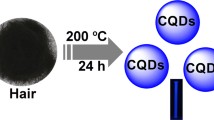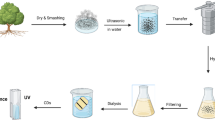Abstract
In this present study, a straightforward and affordable method for the environmentally safe synthesis of carbon quantum dots (CQDs) by employing human hair as the carbon source without any need of chemicals was synthesized. CQDs obtained from human hair was further functionalized with Poly-L-Lysine to form PLLCQDs. The synthesized PLLCQDs was demonstrated numerous advantageous characteristics like strong fluorescence intensity, superior photostability, and outstanding water solubility. Various physicochemical characterization was employed to confirm successful formation of PLLCQDs including UV-vis Spectroscopy, Fluorescence Spectroscopy, Fourier Transform Infrared (FTIR) Spectroscopy, Atomic Force Microscopy (AFM) and Transmission Electron Microscopy (TEM). The size of synthesized PLLCQDs is 3 nm. The resultant PLLCQDs exhibited strong blue emission with a quantum yield of 28%. Under UV light, the synthesized PLLCQDs emit blue (at 365nm) fluorescence. The optimization of synthesis parameters including synthesis method, effect of reaction temperature, effect of reaction time and effect of reaction concentration have a significant impact on the quality and quantity of synthesized PLLCQDs, as well as their properties and applications. The effect of pH and UV radiation on synthesized PLLCQDs exhibited excellent photo and chemical stability. The cytotoxicity of bulk system (Hair precursor) and PLLCQDs was evaluated using fibroblast cell line (L929). The cell viabilities of 99.47% was obtained from L929 cells using MTT assay and it can applicably function as agents for cell labelling as a good bioimaging probe.





Similar content being viewed by others
Data Availability
The dataset generated during and/or analysed during the current study are available from the corresponding author on reasonable request.
Abbreviations
- CQDs:
-
Carbon quantum dots
- PLL:
-
Poly-L-Lysine
- FTIR:
-
Fourier transform infrared spectroscopy
- TEM:
-
Transmission electron microscopy
- MTT:
-
3-(4,5-dimethylthioazol-2-yl)-2,5-diphenyl tetrazolium bromide
- DMEM:
-
Dulbecco’s Modified Eagle’s Medium
- L929:
-
Fibroblast cell line (Non cancer cell line)
- NCCS:
-
National Centre for Cell Science
- PBS:
-
Phosphate Buffer Saline
- UPCL:
-
Up-conversion Photoluminescence
References
Sun D, Ban R, Zhang PH, Wu GH, Zhang JR, Zhu JJ (2013) Hair fiber as a precursor for synthesizing of sulfur- and nitrogen-co-doped carbon dots with tunable luminescence properties. Elsevier. Carbon 423-434
Gupta A (2014) Human hair ‘‘waste’’ and its utilization: Gaps and Possibilities. Journal of Waste Management Volume, Article ID 498018, 17 pages. https://doi.org/10.1155/2014/498018
Brebu M, Spiridon I (2011) Thermal degradation of keratin waste. J Anal Appl Pyrolysis 91(2):288–295
Jung J, Solanki A, Memoli KA, Kamei K, Kim H, Drahl MA et al (2010) Selective inhibition of human brain tumor cells through multifunctional quantum-dot-based siRNA delivery. Angew Chem Int Ed 49(1):103–7
Guo Y, Zhang L, Cao F, Leng Y (2016) Thermal treatment of hair for the synthesis of sustainable carbon quantum dots and the applications for sensing Hg2+. Sci Rep. https://doi.org/10.1038/srep35795
Tao J, Zou H, Lu X, Liao X, Pan J, Li C, Zheng Y (2011) Preparation of strong green fluorescence carbon quantum dots for cancer cell imaging. J Phys Conf Ser. https://doi.org/10.1088/1742-6596
Wang Y, Hu A (2014) Carbon Quantum dots: synthesis, properties and application. J Mater Chem CB. 6921-6939
Yao D, Liang A, Jiang Z (2019) A fluorometric clenbuterol immunoassay using sulfur and nitrogen doped carbon quantum dots. Microchimica Acta B. https://doi.org/10.1007/s00604-019-3431-8
Shahshahanipour M, Rezaei B, Ensafi AA, Etemadifar Z (2019) An ancient plant for the synthesis of a novel carbon dots and its applications as an antibacterial agent and probe for sensing of an anticancer drug. Mater Sci Eng C Mater Biol Appl. https://doi.org/10.1016/j.msec.2019.01.041
Wang Y, Hu A (2014) Carbon quantum dots: synthesis, properties and applications. J Mater Chem C. https://doi.org/10.1039/c4tc00988f
Janus Ł, Radwan-Pragłowska J, Piątkowski M, Bogdał D (2020) Facile synthesis of surface-modified carbon quantum dots (CQDs) for biosensing and bioimaging. Materials. https://doi.org/10.3390/ma13153313
Pan M, Xie X, Liu K, Yang J, Hong L, Wang S (2020) Fluorescent carbon quantum dots—synthesis, functionalization and sensing application in food analysis. Nanomaterials. 10:930. https://doi.org/10.3390/nano10050930
Vibhute A, Nille O, Kolekar G, Rohiwal S, Patil S, Lee S, Tiwari AP (2022) Fluorescent carbon quantum dots functionalized by poly-l-lysine: efficient material for antibacterial, bioimaging and antiangiogenesis applications. J Fluoresc. https://doi.org/10.1007/s10895-022-02977-4
Ozdemir KG, Yılmaz H, Yılmaz S (2008) In vitro evaluation of cytotoxicity of soft lining materials on L929 cells by MTT assay. J Biomed Mater Res. https://doi.org/10.1002/jbm.b.31256
Nematia F, Hosseinib M, Zare-Dorabeia R, Salehniad F, Ganjali MR (2018) Fluorescent turn on sensing of Caffeine in food sample based on sulfur-doped carbon quantum dots and optimization of process parameters through response surface methodology. Sens Actuators B. https://doi.org/10.1016/j.snb.2018.05.163
Pooja D, Saini S, Thakur A, Kumar B, Tyagi S, Nayaka MK (2017) A “Turn-On” thiol functionalized fluorescent carbon quantum dot based chemosensory system for arsenite detection. J Hazard Mater. https://doi.org/10.1016/j.jhazmat.2017.01.015
Prasada KS, Shruthi G, Shivamallu C (2019) One-pot synthesis of aqueous carbon quantum dots using bibenzoimidazolyl derivative and their antitumor activity against breast cancer cell lines. Inorg Chem Commun. https://doi.org/10.1016/j.inoche.2019.01.001
Emam HE, Ahmed HB (2020) Antitumor/antiviral carbon quantum dots based on carrageenan and pullulan. Int J Biol Macromol. https://doi.org/10.1016/j.ijbiomac.2020.12.151
Malavika JP, Shobana C, Ragupathi M, Kumar P, Lee YS, Govarthanan M, Selvan RK (2021) A sustainable green synthesis of functionalized biocompatible carbon quantum dots from Aloe barbadensis miller and its multifunctional applications. Environ Res. https://doi.org/10.1016/j.envres.2021.111414
Ghosh S, Ghosal K, Mohammad SA, Sarkar K (2019) Dendrimer functionalized carbon quantum dots for selective detection of breast cancer and gene therapy. Chem Eng J. https://doi.org/10.1016/j.cej.2019.05.023
Shamsipur M, Barati A, Abdollahi H (2015) Haemoglobin detection using carbon dots as a fluorescence probe. Biosens Bioelectron. https://doi.org/10.1016/j.bios.2015.04.073
Gao G, Jiang YW, Yang J, Wu FG (2017) Mitochondria-targetable carbon quantum dots for differentiating cancerous cells from normal cells. Nanoscale. https://doi.org/10.1039/C7NR06764J
Gujar V, Pathan H, Islam S, Tawre M, Pardesi K, Santra MK, Ottoor D (2019) Bioimaging applications of carbon dots (c. dots) and its cystamine functionalization for the sensitive detection of Cr (VI) in aqueous samples. J Fluoresc. https://doi.org/10.1007/s10895-019-02448-3
Arumugham T, Alagumuthu M, Amimodu RG, Munusamy SK, Iyer SK (2019) A sustainable synthesis of green carbon quantum dot (CQD) from Catharanthus roseus (white flowering plant) leaves and investigation of its dual fluorescence responsive behavior in multi-ion detection and biological applications. Sustain Mater Technol. https://doi.org/10.1016/j.susmat.2019.e001382214-9937
Shi C, Qi H, Ma R, Sun Z, Xiao L, Wei G, Huang Z, Liu S, Li J, Dong M, Fan J (2019) N, S-self-doped carbon quantum dots from fungus fibers for sensing tetracyclines and for bioimaging cancer cells. Mater Sci Eng. https://doi.org/10.1016/j.msec.2019.110132
Tyagi A, Tripathi KM, Singh N, Choudhary S, Gupta RK (2016) Green synthesis of carbon quantum dots from lemon peel waste: Applications in sensing and photocatalysis. RSC Adv. https://doi.org/10.1039/C6RA10488F
Bhattacharya D, Kumar Vinay, Packirisamy Gopinath (2021) Biocompatible carbon nanodots from red onion peels for anti-oxidative and bioimaging application. Mater Express. https://doi.org/10.1166/mex.2021.2101
Zhu J, Zhu F, Yue X, Chen P, Sun Y, Zhang L, Dongdong M, Ke F (2019) Waste utilization of synthetic carbon quantum dots based on tea and peanut shell. J Nanomater Vol. https://doi.org/10.1155/2019/7965756
Ngu PZ, Chia SPP, Fong JFY, Ng SM (2016) Synthesis of carbon nanoparticles from waste rice husk used for the optical sensing of metal ions. New Carbon Mater. https://doi.org/10.1016/S1872-5805(16)60008-2
Hu Y, Gao Z (2019) Sewage sludge in microwave oven: A sustainable synthetic approach toward carbon dots for fluorescent sensing. J Hazard Mater. https://doi.org/10.1016/j.jhazmat.2019.121048
Wang R, Li G, Dong Y, Chi Y, Chen G (2020) Carbon quantum dot-functionalized aerogels for NO2 gas sensing. Anal Chem. https://doi.org/10.1021/ac401880h
Rooj B, Dutta A, Islam S, Mandal U (2018) Green synthesized carbon quantum dots from polianthes tuberose L. Petals for Copper (II) and Iron (II) detection. J Fluoresc. https://doi.org/10.1007/s10895-018-2292-6
Tadesse A, Belachew N, Hagos M, Basavaiah K (2021) Synthesis of fluorescent nitrogen and phosphorous co-doped carbon quantum dots for sensing of iron, cell imaging and antioxidant activities. J Fluoresc. https://doi.org/10.1007/s10895-021-02696-2
Lv R, Li G, Shuting L, Wang T (2021) Synthesis of multi-functional carbon quantum dots for targeted antitumor therapy. J Fluoresc. https://doi.org/10.1007/s10895-020-02661-5
Zhang JH, Niu A, Li J, Fu JW, Xu Q, Pei DS (2016) In vivo characterization of hair and skin derived carbon quantum dots with high quantum yield as long-term bio probes in zebrafish. Sci Rep. https://doi.org/10.1038/srep37860
Zhou M, Zhou Z, Gong A, Zhang Y, Li Q (2015) Synthesis of highly photoluminescent carbon dots via citric acid and tris for iron (III) ions sensors and bioimaging. Talanta. https://doi.org/10.1016/j.talanta.2015.04.015
Arumugham T, Alagumuthu M, Amimodu RG, Munusamy SK, Iyer SK (2020) A sustainable synthesis of green carbon quantum dot (CQD) from Catharanthus roseus (white flowering plant) leaves and investigation of its dual fluorescence responsive behavior in multi-ion detection and biological applications. Sustain Mater Technol. https://doi.org/10.1016/j.susmat.2019.e00138
Kumari A, Kumar A, Sahu SK, Kumar S (2020) Synthesis of green fluorescent carbon quantum dots using waste polyolefins residue for Cu2+ ion sensing and live cell imaging. Sens Actuators. https://doi.org/10.1016/j.snb.2017.07.075
Nasseri Mohammad Ali, Keshtkar Hamidesh, Kazemnejadi Milad, Allahresani Ali (2020) Phytochemical properties and antioxidant activity of Echinops persicus plant extract. Springer Nature Switzerland A Switzerland AG. https://doi.org/10.1007/s42452-020-2466-0
Varisco M, Zufferey D, Ruggi A, Zhang Y, Mamula REO (2021) Synthesis of hydrophilic and hydrophobic carbon quantum dots from waste of wine fermentation. Royal Soc. https://doi.org/10.6084/m9/figshares
Vibhute A, Patil T, Gambhir R, Tiwari AP (2022) Fluorescent carbon quantum dots: Synthesis methods, functionalization and biomedical applications. Appl Surf Sci Adv. https://doi.org/10.1016/j.apsadv.2022.100311
Martins NC, Ângelo J, Girão AV, Trindade T, Andrade L, Mendes A (2016) N-doped carbon quantum dots/TiO2 composite with improved photocatalytic activity. Appl Catal B. https://doi.org/10.1016/j.apcatb.2016.04.016
Huo X, Liu L, Bai Y, Qin J, Yuan L, Feng F (2021) Facile synthesis of yellowish-green emitting carbon quantum dots and their applications for phoxim sensing and cellular imaging. Anal Chim Acta. https://doi.org/10.1016/j.aca.2021.338685
Vibhute A, Patil T, Malavekar D, Patil S, Lee S, Tiwari AP (2022) Green synthesis of fluorescent carbon dots from annona squamosa leaves: optical and structural properties with bactericidal, anti-inflammatory, anti-angiogenesis applications. J Fluoresc. https://doi.org/10.1007/s10895-023-03159-6
Malavika JP, Shobana C, Sundarraj S, Ganeshbabu M, Kumar P, Selvan RK (2022) Green synthesis of multifunctional carbon quantum dots: An approach in cancer theragnostic. Biomater Adv. https://doi.org/10.1016/j.bioadv.2022.212756
Acknowledgments
The work acknowledges Intramural University project, entitled “Targeted Destruction of cancer stem cell by surface functionalized magnetic nanoparticles’’(Project No. DYPES & D/2021/274), D. Y. Patil education society, Kolhapur. The authors also acknowledge the funding support from Mylab discovery solution pvt. ltd., Pune.
Funding
This work was supported D. Y. Patil Education Society, (Deemed to be University), Kolhapur for providing required infrastructure, experimental facility and the financial support through intramural project (No. DYPES/DU/R&D/2021/274). The authors also acknowledge the funding support from Mylab discovery solution pvt. ltd., Pune.
Author information
Authors and Affiliations
Contributions
Ms. Pranoti Kamble has performed the experiments, contributed to the design of the study, and wrote the manuscript. Dr. Dhanaji Malavekar has contributed in TEM analysis. Dr. Arpita Pandey Tiwari contributed to the design of the study, wrote the manuscript, and provided funding support. All authors read and approved the submission of the final manuscript.
Corresponding author
Ethics declarations
Ethical Approval
Not applicable.
Consent to Participate
Not applicable.
Consent for Publication
Not applicable.
Conflict of Interest
The authors declare no conflict of interest.
Additional information
Publisher's Note
Springer Nature remains neutral with regard to jurisdictional claims in published maps and institutional affiliations.
Rights and permissions
Springer Nature or its licensor (e.g. a society or other partner) holds exclusive rights to this article under a publishing agreement with the author(s) or other rightsholder(s); author self-archiving of the accepted manuscript version of this article is solely governed by the terms of such publishing agreement and applicable law.
About this article
Cite this article
Kamble, P., Malavekar, D. & Tiwari, A.P. Natural Biowaste Derived Fluorescent Carbon Quantum Dots: Synthesis, Characterization and Biocompatibility Study. J Fluoresc 34, 191–201 (2024). https://doi.org/10.1007/s10895-023-03244-w
Received:
Accepted:
Published:
Issue Date:
DOI: https://doi.org/10.1007/s10895-023-03244-w




